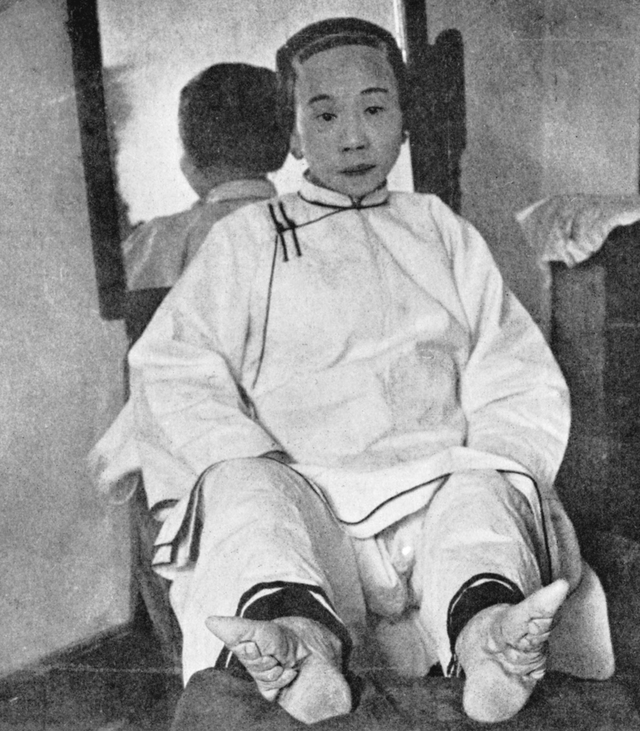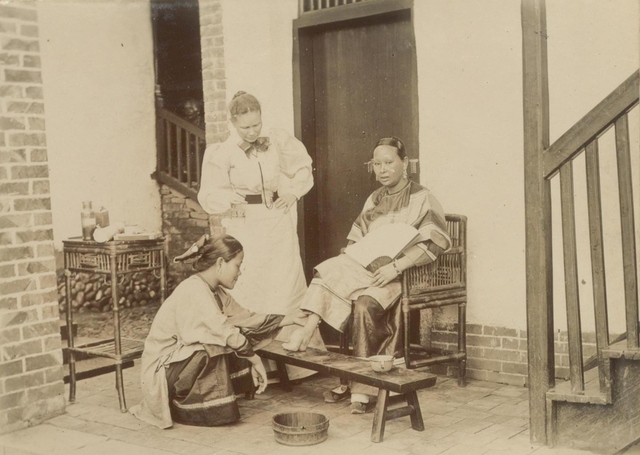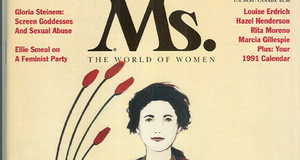Revisiting Footbinding: The Evolution of the Body as Method in Modern Chinese History
By
2014, Vol. 6 No. 10 | pg. 1/2 | »
KEYWORDS:
For scholars of gender and sexuality, the publication of Joan Wallach Scott’s acclaimed essay “Gender: A Useful Category of Historical Analysis” in the 1970s was a remarkable moment. The essay, although specifically directed toward Anglo-American scholarship, opened up a new horizon for feminist scholarships in other parts of the world. Scott would probably not have foreseen that her work would serve as “a working guide on how to bushwhack and read partially obscured tracks”1 for feminist scholars of China. Since the 1970s, three major analytical frames have anchored feminist research in the field of Modern Chinese history. The first wave of studies, emerging at the beginning of the Cultural Revolution, focused their line of inquiry on the anthropological investigations of women, kinship and network formation. These studies drew on various ethnographic records of women’s marital kinship networks to analyze the gendered nature of the patrilineal marriage system and women’s affective responses to this system. Less ethnographically intensive, and more attentive to a historical trajectory of the nation-state, the second line of studies revolved around the roles of the twentieth-century Communist revolution in the liberation of women from a feudalistic Confucian tradition. It also embroiled many scholars in heated debates over the nature of this revolution, and if the progressive and emancipatory ideologies it espoused indeed liberated women. The final line of inquiry began to pay more attention to areas otherwise obfuscated by an over-emphasis on ethnography and ideological narratives such as women’s labor, political participations, and sex.These three major analytical frames formed strong, collective wings under which feminist scholarships in Modern Chinese history proliferated and offered unprecedented insights into the lives of women since the turn of the twentieth-century. However, one may wonder: what remained unexamined? Swinging along with major movements in the field of historical studies, China scholars began to direct their attentions to Western critical traditions. The 1990s marked a new decade of scholarships that, in the robust gravitational force of the cultural turn, applied the ideas of Michel Foucault or Jacques Derrida to the theoretical undertaking of feminist analyses in historical studies. The flowering of the new cultural history gave rise to the births of studies that challenged the dominant paradigm of revolutionary narratives and slowly shifted the focuses to female bodies, subjectivities and embodiment.
I mainly explore three major monographs on footbinding by Fan Hong, Wang Ping, and Dorothy Ko. In examining these monographs in a chronology that spanned the new cultural history era, my goal is to survey and articulate the evolution of the body in Modern China not only as a debate, but also as a shifting discourse on methods through which a more nuanced women’s history could be written. The return of the “body” as a conceptual scheme in Chinese feminist scholarships challenges the revolutionary paradigm dominating Chinese historiography since the turn of the 20th century. This paradigm posits that the modern multi-phased ideological revolutions in China liberated the women’s bodies and provided them with agencies that were previously deprived by traditionalism. By revisiting footbinding—a classic representative of feudal traditions condemned by revolutionaries, I demonstrate how these monographs by three prominent feminist scholars have advanced our understandings of the Chinese women’s bodies and thus redefine concepts of female agencies and subjectivities. The paradigm of footbinding scholarships have shifted from a narrative of bodily liberation to a reinvestigation of the bound feet, showing how women actively engaged in such practice through management of their bodies at the face of an oppressive tradition. Agencies therefore should not be narrowly understood as resistance to traditionalism, but also as engagement. Bodily pain should not be relegated to mere destruction, but also an analytical lens through which concepts of the self and womanhood are explicated. These three monographs along with their new treatments of the bodies have important implications for future feminist research not only in history, but also other areas such as anthropology, sociology and many more. They call for a critical shift away from an existing problematic paradigm to study female embodiment through previously condemned anchors such as pain and trauma. Bound foot (unbound) - Photo: William Charles White (n.d.) NC-2 Published in 1997, a moment when new feminist scholarships in China began to turn its conduit, Fan Hong’s monograph titled Footbinding, Feminism, and Freedom: The Liberation of Women’s Bodies in Modern China was a major contribution to the field. Through a refreshing lens of sports, Fan juxtaposed the traditional practices of footbinding to the women’s empowerment movements in the 1920s that promoted the strengthening of female physicality by means of intensive exercises. In so doing, she proposed that sports provided a critical lens to highlight women’s struggle to reclaim their bodies and illuminate the domain of resistance, hitherto unexplored, to the state stereotypical and male-dominated perception of women as frail, fragile, and incapacitated. Footbinding was therefore portrayed in a diametric opposition to exercise and sports. If the former was the evil force of traditionalism that mutilated the women’s feet through excruciating violence and unspeakable pains for a societal standard of beauty that dispossessed women’s bodies, the latter then remained a platform of struggles for women to exercise their agencies. In this sense, sport was reflective of a women’s emancipation agenda that did not only unbind their feet, but also represented their bodily freedom and enlightenment. The act of unbinding women’s feet was symbolically equivalent to progressivism and the rise of a cultural revolution. Footbinding, in Fan’s analytical framework, was thus the anti-thesis to modernity, a classic feminist critique of feudalistic traditional practices that encroached upon the territory of the female bodies. At this moment, Fan’s analytical perspectives of the female body as a site of agency and subversion was particularly powerful especially when footbinding had been conventionally perceived in the history of modern China to be an inveterately ominous social practice that deprived women of the abilities to control their bodies. The body that emerged as a new conceptual material enabled scholars to explicate not only the infringement of freedom and power inscribed upon it, but also the possibilities for active agencies and potentials for deeply invested feminist’s political discourses in China. On realizing these potentials, many scholars began to shift their attention to body politics and now raise legitimate questions regarding this new realm of inquiry, many of which actively built upon and challenged Fan’s “bodily freedom” thesis. If participating in exercise or sports could be regarded as performing modernity and subversive acts to bodily repression, such as the social custom of footbinding, what was at stake or lacking in the pursuit of this narrative? How do we then make sense of footbinding as a female bodily practice that galvanized generations of Chinese women to follow it? While Fan’s espousal of the body as a conceptual tool to interpret the roles of footbinding in twentieth-century Chinese feminist discourse proved to be groundbreaking, her treatment of the body remained relatively insufficient. At the heart of this emerging academic inquiry was the question of how Chinese women understood their bodies through a traumatizing and violent practice such as footbinding, and how footbinding could be analyzed as a form of female embodiment. What were the appeals of tiny feet, sometimes metaphorically referred to as “golden lilies,” and the eroticism deriving from fetish and desires that encompassed this complex traditional custom? In the event of these emerging inquiries regarding a new form of feminism and subjectivities, fervent critics of Fan’s foundational work often pointed to her use of the body-as-resistance and sport-as-liberation framework a weakness that needed further theorization. They cited the binary created between body and emancipation as a reproduction of the enlightenment discourse promulgated by the nation-state. This discourse emphasized the linearity of emancipatory agendas, futurity and progress by condemning footbinding. The stake of this ideological narrative was its neglect of the power aspect of sport as state-enforcing scheme and its potential influences on the way scholars positioned the women’s body in history. In addition, the dominant Marxist temporality model of supersession tended to obscure historical residues—bodies that did not fit revolutionary narratives—that resisted to the aggressive leaps and bounds of progressive discourses. Fan’s historical narrative consequently emphasized women’s bodies as crucial analytical instruments, but critics have pointed out, that these particular bodies followed a temporal mode envisioned by the states. Fan’s problematic framework thus marginalized those confrontational, stubborn bodies that resisted the state’s linear vision of progress. It was in this effort to defy the nation-state’s revolutionary phraseology and the ontological discourse of progress that scholars sought to deconstruct this quotidian self-perception of femininity and empowerment in their experiences with footbinding. As a result, the next track of feminist scholarships on footbinding in China continued to build on Fan’s conceptual layout in her acclaimed work, and turn their academic inquiries to the exploration of female agencies through the practices of footbinding itself, rather than through an active resistance to and vilification of it. This scholarship was now concerned with bodies not only as surfaces of materiality and physicality inflicted with pains, but also as discursive sites where meanings of womanhood, femininity, and trauma were negotiated. Employing this shifting analytical framework, Wang Ping’s work titled Aching For Beauty, Footbinding in China, published three years later, was a major turn in the writing of footbinding and body politics in China. Even though Wang’s work was not a historical monograph per se, through the means of literary criticism, it “explores the link between beauty and violence, mutilation and language, taboo and transgression, the links that characterized footbinding.”2 In exploring the linkages among the attributes that constituted the practice, Wang situated her literary analysis squarely into a dialogue with Fan’s overlooked aspects of female embodiment. This book was comprehensive, well-researched and rich with a wide array of sources about a hundred years of Chinese art and literary traditions that depicted the evolutionary moments of footbinding. Using these sources, Wang focused on the aesthetics of footbinding as a form of feminine expressions, a demarcation of gender and a defined marker of beauty. As she concluded in this monograph, “as feet are bound and rebound, the body part (nature) is turned into a work of artifice, then transformed back into nature as the only proof of true femininity, true gender and sex. Thus footbinding brings out a series of critical issues of the quest for beauty that always goes hand in hand with violence, the making of culture, of hierarchy, of gender and sex, and finally, the making and remaking of nature.”3 The body for Wang was a work of art, or at least widely understood so, among women. This body must be damaged, mutilated and deformed so that it could gain meaningfulness and legitimacy to the Other. If a man were defined as a man because he possessed a penis, a woman would only be a woman until she acquired small feet. The negotiation of the women’s bodies only occurred because the only way for her to express her femininity and beauty was self-mutilation. Violence became a language that was equivalent to a worthy cause, a voluntary act of bodily beautification, and sacrifice. “Through the furnace of language, footbinding cooked the raw, wild female body into cultural artifice, introducing it into erotic games and economic cycles.”4Continued on Next Page » Suggested Reading from Inquiries Journal
Inquiries Journal provides undergraduate and graduate students around the world a platform for the wide dissemination of academic work over a range of core disciplines. Representing the work of students from hundreds of institutions around the globe, Inquiries Journal's large database of academic articles is completely free. Learn more | Blog | Submit Latest in History |




















